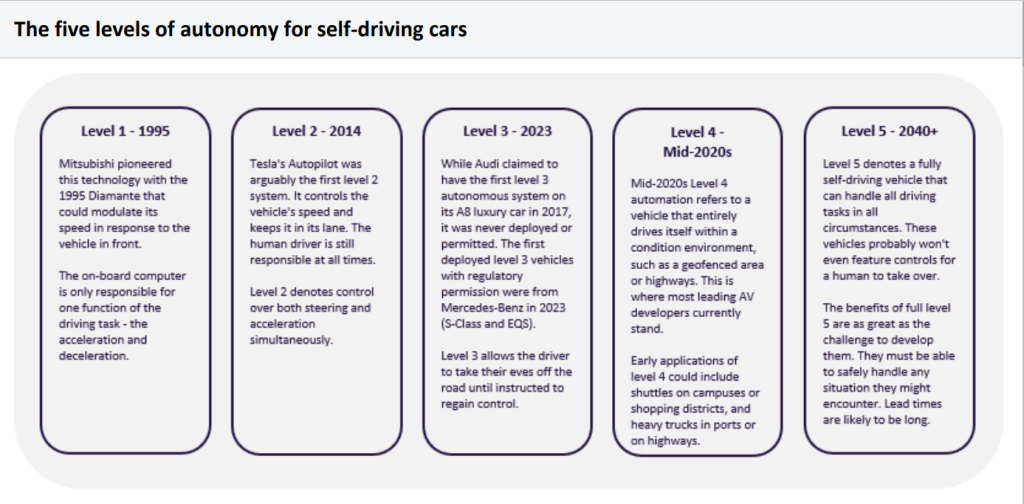
As the automotive industry hurtles toward an autonomous future, Juan Destribats explores the journey of these vehicles, looking at recent incidents, technological advancements, and the intricate regulatory landscapes that shape the future of transportation.
The once-fantastical concept of autonomous transportation has morphed into a focal point for car manufacturers and tech giants, captivating the imagination of consumers and attracting substantial investment. However, the trajectory toward a world of self-driving vehicles is fraught with challenges on multiple fronts, ranging from technological intricacies to the intricate web of global regulations governing their deployment.
The promise and the pitfalls
Autonomous driving, projected to generate between $300 billion to $400 billion by 2035, holds the potential to revolutionise transportation fundamentally. A McKinsey study paints a rosy picture of reduced accidents by 15% through the adoption of advanced driver-assistance systems (ADAS) in Europe by 2030. The allure of increased safety and transformative transportation experiences has become a driving force behind the substantial investments pouring into the autonomous vehicle sector.

Navigating complexity
The Society of Automotive Engineers (SAE) has established a classification system to define the autonomy levels of vehicles. However, despite significant investments in research and development, the latest generation of vehicles is yet to achieve the coveted SAE levels 4 or 5 efficiency. The intricate technology required for autonomous vehicles, encompassing advanced software and sensor systems, raises concerns about both the efficiency and safety of unleashing highly autonomous vehicles onto public roads.
Incidents and public perception
Recent incidents have cast shadows on the perceived safety of autonomous vehicles. A former Tesla employee, Lukasz Krupski, publicly expressed doubts about the safety of Tesla’s self-driving technology, stating, “I don’t think the hardware is ready, and the software is ready.” An investigation by the American National Highway Traffic Safety Administration (NHTSA) into pedestrian injuries involving a General Motors subsidiary’s self-driving cars adds fuel to the scepticism. Incidents like these not only jeopardise public perception but also act as setbacks for companies striving to regain trust.
A Pew Research survey conducted in 2021 provides insight into the mixed feelings among US adults regarding self-driving vehicles. While nearly half expressed a willingness to use autonomous cars, 21% were resistant, and 31% remained uncertain — a testament to the complex relationship between technology and public trust.

US Tariffs are shifting - will you react or anticipate?
Don’t let policy changes catch you off guard. Stay proactive with real-time data and expert analysis.
By GlobalDataExpanding Horizons
Despite concerns, the industry’s ambitions for autonomous transportation extend beyond traditional cars. In May 2023, Autonomous Bus Technology Ltd, a UK-based provider of autonomous vehicle technology, launched the UK’s first self-driving buses. These buses, designed to navigate complex urban environments, adhere to traffic laws, and prioritise passenger safety, signal a move toward sustainable and efficient public transportation. Industry leaders like Alfio Capicollo of YSM Motors applaud such initiatives, emphasising the potential benefits of autonomous public transportation.
Capicollo notes, “The introduction of self-driving buses on UK roads mirrors a global trend in urban innovation and could serve as an inspiration for cities worldwide. The potential benefits, from reducing congestion and carbon emissions to increasing safety and providing round-the-clock service, are plentiful.” However, he cautions that strategic implementation and public acceptance are critical for the success of such technological advancements.
Technological strides and regulatory challenges
Global Data analyst and autonomous vehicles expert Sammy Chan shed light on the determinants of success for autonomous vehicles in the automobile market. He emphasises that autonomous vehicles face two uphill battles – the technological aspect and the regulatory aspect.
In terms of technology, the leap between each level of autonomy becomes more significant, with each step from level 1 through 5 posing unique challenges. Chan highlights, “Each negative story about AVs sets the companies back as they look to regain the trust of the public and lawmakers alike.” Recent delays, such as the Cruise Origin, a level 4 AV scheduled for production in 2024, underscore the complexity of technology and regulations.
Addressing the regulatory aspect, Chan notes the challenge posed by varying regulations across countries and even states within the US. Each region has its own set of rules governing what an autonomous vehicle can and cannot do, as well as where it can operate. This diversity in regulations contributes to delays and setbacks in the realistic rollout of autonomous vehicles in mass production.
“Due to the reasons above, the realistic rollout of AVs in mass production is likely a long way off, with further setbacks inevitable,” concludes Chan. Nevertheless, the significant investments from the US, Europe, Japan, Korea, and China ensure that the development of AVs will continue, albeit with challenges that need to be navigated carefully.
In this intricate dance between technology, regulation, and public perception, the future of autonomous vehicles hangs in the balance. As the industry forges ahead, it must address the concerns raised by incidents, overcome technological hurdles, and navigate the complex web of regulations to steer toward a future where self-driving vehicles are not just a vision but a reality.







